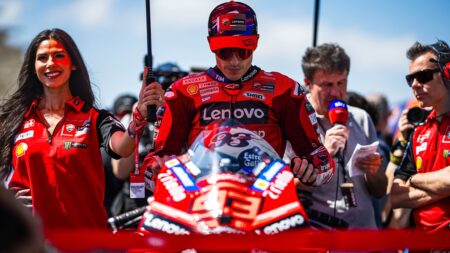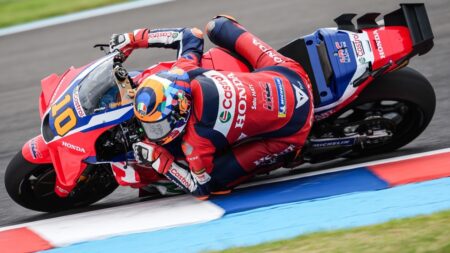As you read this, the wheels are probably still turning and the spanners still twirling at Valencia’s first off-season tests where the game is the same as it’s been for years: hunt the Honda.

We all know the RC213V is the best bike on the MotoGP grid right now (it’s won three riders’ titles and four constructors’ crowns over the last four years) and we all know why: because while Yamaha’s YZR-M1 carves the line of beauty – nicely arced all the way through the corner – the Honda is in and out, front tyre tucked on entry and a flurry of wheelspin (not too much, not too little) on the exit.

Álex Márquez followed by brother Marc
And not forgetting, of course, the most important item on the RCV part list: the fleshy and brave hi-tech computer that holds the handlebar grips. After all, it is only Marc Márquez who can ride the bike the way it needs to be ridden to fully exploit its genius design.
The Honda is short and wiry and fully wired up for 21st century race tracks. If MotoGP was still dominated by age-old venues like Phillip Island with grand, sweeping curves, the M1 would be a difficult motorcycle to beat. But tight turns and chicanes are the stuff of 21st century MotoGP tracks and through this kind of corner the Honda steals a metre or two on the Yamaha. Half a dozen turns like that per lap, multiplied by 25 laps, equals the Honda a hundred metres ahead at the chequered flag.
So what are Yamaha and the others going to do about it?
Stupid question, really.
Yamaha is trying to improve corner entry and corner exit performance. No shit, Sherlock! Valentino Rossi and Jorge Lorenzo have been begging Yamaha for some while for a fully seamless gearbox, so they can downshift seamlessly into corners, as Márquez can. But since Yamaha first raced its seamless upshift gearbox two and a half years after Honda, they might be in for a long wait.

“I hope we can get this new gearbox,” says Rossi, Yamaha’s top rider for the first time since 2009. “I always ask Yamaha: when, when, when, when?!”
In the meantime, Yamaha has a new chassis. “For better braking and entry and to stress the front tyre less, because this is where the Honda has the biggest advantage,” adds Rossi.
However, Rossi doesn’t expect Honda to build an RC213V for 2015. “When the Yamaha improves, its style will remain the same because the two bikes are different in the heart,” he says. “Honda will never have our corner speed and we will never have the Honda’s tight turning.”
Not much point talking about Ducati until we see the GP15 at Sepang in February. “We need different geometry to fix the understeer problem and we cannot have that geometry with our current engine,” says Gigi Dall’Igna. “The GP15 engine will be smaller, because for a chassis designer it’s really important to have the engine as small as possible.”
To say the least, Suzuki didn’t have the most auspicious of starts to its latest MotoGP adventure last weekend: two engine blow-ups, 12mph down on top speed, 20th on the grid and out of the race with gearbox trouble. A bit of a disaster, perhaps, but people inside the blue garage believe the future is brighter than that. In racing, you have to be an optimist; it’s compulsory.

Suzuki’s main problem is a major lack of horsepower. At the wildest of guesses, it’s got about 230 horses and it needs 260 to get close to the Honda.
But what about the chassis? Aleix Espargaró was delighted with that side of the GSX-RR, enthusing about the bike’s ability to fire straight at the apex, deep on the brakes. Just like the Honda. And his lap times bore proof: despite the lack of horses Espargaró was soon lapping faster than he’d done on the Forward Yamaha during Sunday’s race.
“Aleix’s first comments about the chassis were really positive,” says Espargaró’s crew chief Tom O’Kane. “But when you hear a rider saying that the bike gets into corners really well, the engineering part of your brain is going, ‘Oh, I wonder if we’re losing anything on corner exit’.
“But good turning is good turning and you take it any time you can get it. If the bike turns better off the throttle or on the throttle then you’ve gained something that hasn’t hurt anything else, so it’s a bonus. I know that the idea behind the Suzuki chassis is really good, a lot of careful thought has been put into it.”

O’Kane’s bigger concern is corner exit. “The Honda’s biggest advantage is accelerating out of slow corners when the grip is low, that’s when the Honda steals a couple of metres, so we have to match that.”
Suzuki isn’t in a panic about the lack of horsepower, which is a dream of a problem compared to Ducati’s apparently never-ending understeer nightmare.
“If you’ve got a problem with the bike not turning, there’s nothing you can do about it before the next test, which might be five weeks away,” adds O’Kane. “Whereas if you’ve got a horsepower problem you can work on it day and night, so it’s not the worst problem to have.”
If most people’s expectations for the Suzuki are low, so should they be for the Aprilia, because the bike turning laps at Valencia isn’t the factory’s real MotoGP bike. So far, all Aprilia has done is bolted a pneumatic-valve-spring top end to a heavily breathed-on RSV4 road bike motor and stuck it in a chassis based on the ART of the last few years.

Its first full-on MotoGP bike since the RS3 Cube won’t hit the test track until next September, in order to be ready to race in 2016, which is cleverer than you might think because its genesis will coincide precisely with the switch to Michelin tyres and Dorna’s control ECU.
The question then, of course, is what will the Michelins do to Honda’s corner-entry advantage and what will the lower-tech electronics do to its corner-exit advantage? Because there’s no way that Honda will be stupid enough to give away all its hard-won electronics know-how to the rest of the world by allowing Magneti Marelli to write its genius code into the control ECU. It would be insane to do that and Honda is not insane.
“No,” grins O’Kane. “Honda will give us the Fisher Price version of what they’re running now and they’ll be content to run that themselves.”










